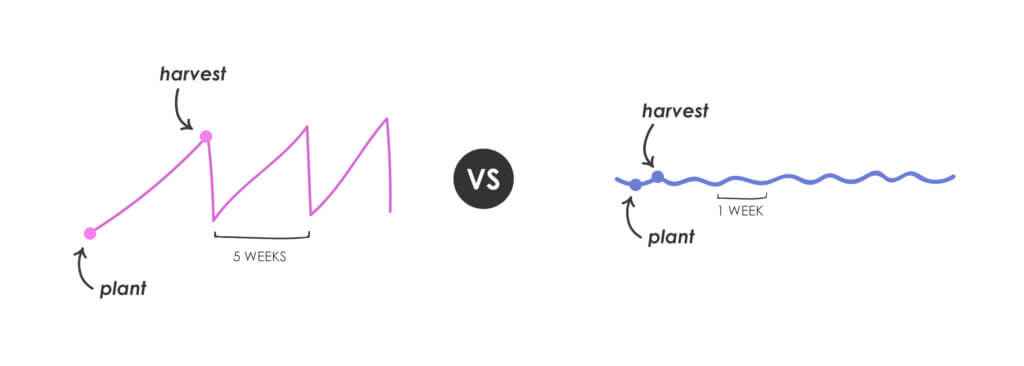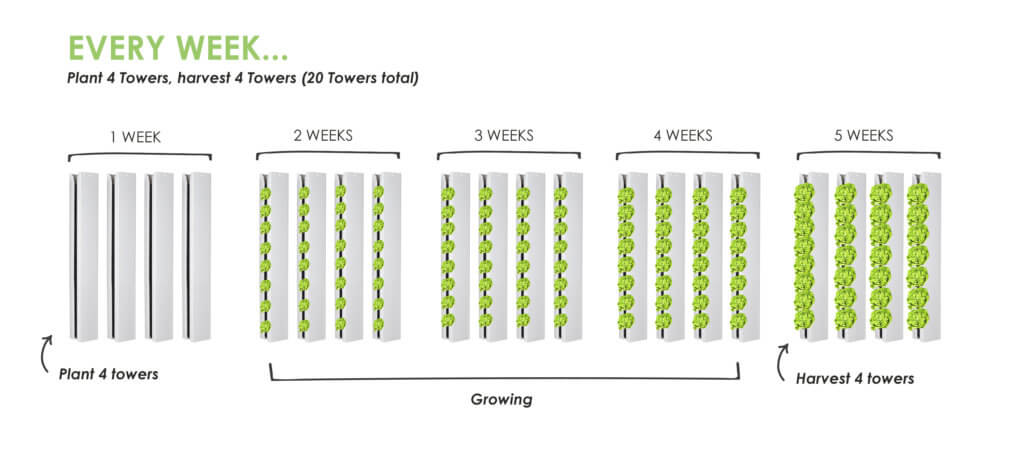Take a farming tip from Nick: don’t plant the whole farm at once!
Quick farming tip from Nick Marasco: Don’t fill the whole system up all at once.
If you grow the entire farm full of crops that were started all at the same time, you get production waves instead of continuous production. Continuous production is what farmers need to satisfy weekly or even bi-weekly demand. This way you always have mature crops in the farm.

As a new farmer, Nick seeded and planted thousands of plants all at once and filled up the entire ZipFarm as soon as it was functional! He quickly realized his mistake—the result was a huge amount of produce harvested all at once. He ended up having to donate much of the produce.
Now Nick keeps a planting and harvesting schedule that accounts for the life cycles of each crop.
Here’s how the schedule works in good growing conditions:
- Greens like chard, lettuce, or cabbage have a 5- to 6-week turn from transplant to harvest.
- Quick herbs like chives and mint have a 3- to 4-week turn between harvests.
- Woody (slow) herbs like oregano and rosemary have a 7- to 9-week turn between harvests.
- Cilantro, parsley, and basil have a 5-week turn when conditions are right.
- Strawberries and tomatoes produce continually. (They can be planted all at once.)
- Microgreens vary from 10–20 days. (See arugula’s timeline here.)
Say you’re selling lettuce to a restaurant, Torento’s Deli. They’ve asked for 15 lbs of lettuce per week. You harvest your lettuce at 5 weeks and conservatively estimate that each head will be 0.5 lbs. You’re growing 8 heads per ZipGrow Tower (4 lbs/tower), so you know it will take 4 Towers each week. This ends up being 16 lbs, giving you some wiggle room if a head or two is lost.

Since your lettuce is on a five-week turn, however, and you’re doing weekly deliveries, you actually need to have 4 Towers for every week of that turn. This means that you’ll have 20 Towers of lettuce growing at any given time, and you’ll harvest 4 and plant 4 every week.

This way, you can continually harvest lettuce for Torento’s Deli.
You also know now that Torento’s account will require 20 Towers worth of space in your greenhouse, and you can plan accordingly. When you plan out planting and harvesting schedules, don’t over promise produce that you can’t provide!
So how do you build a planting schedule?
1) Using what you know about your production estimates, demand volume, and growing time, calculate how much you need to be harvesting and planting each week. If demand is recurring like Torrento’s, these two numbers will be the same!
2) Multiply weekly demand by the weeks in the crop’s “turn” to determine how much space you will need for that account. Don’t exceed your space!
3) There are tons of apps and programs you can use to create reminders and to-do lists, from spreadsheets like Excel or Google Sheets, to task organizers like Trello or Basecamp. You could even use Reminders on an Apple device to schedule tasks.
Have questions? Leave them in the comments!



now that able is no more, it would be helpful if you could provide some more help in creating a schedule. Maybe some sample spreadsheets? I found a lot online but they are all for in ground growing and I am not sure how to modify them.
Hey Andy, great question. Agrilyst is another software that you should check out – they have some scheduling function as well. We’re also working on something more specific. If you have suggestions/specific needs I would love to hear them!
I attended the Agrilyst webinar and thank you for having that for us. I think that’s more than what I need at this time. My specific needs are scheduling the crops. If I have a known harvest date, working out all of the other scheduling like seeding, transplanting, partial and full harvesting dates. How many towers do I need to meet a specific quantity or weight demand. Agro seemed to be what I needed but Agrilyst is more than I need and more $ than I am willing to part with at this time.
Now that Able is not a commercial product anymore, is there any chance that the code would be open sourced?
Hey Mark, unfortunately, no, but we have put all of the calculators that were in Able on this page: https://university.upstartfarmers.com/calculators
oops..not agro…able
dear sir I need to praper a crop calendar of wheat. if you support me.